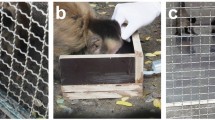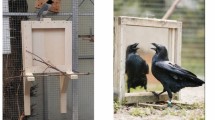Abstract
Classic mirror self-recognition mark tests involve familiarizing the subject with its mirror image, surreptitiously applying a mark on the subject’s eyebrow, nose, or ear, and measuring self-directed behaviors toward the mark. For many non-human primate species, however, direct gaze at the face constitutes an aggressive and threatening signal. It is therefore possible that monkeys fail the mark test because they do not closely inspect their faces in a mirror and hence they have no expectations about their physical appearance. In the current study, we prevented two pig-tailed macaques (Macaca nemestrina) from seeing their own faces in a mirror, and we adopted a modified version of the classic mark test in which monkeys were marked on the chest, a body region to which they normally have direct visual access but that in the current study was visible only via a mirror. Neither monkey tried to touch the mark on its chest, possibly due to a failure to understand the mirror as a reflective surface. To further the monkeys’ understanding of the mirror image, we trained them to reach for food using the mirror as the only source of information. After both monkeys had learned mirror-mediated reaching, we replicated the mark test. In this latter phase of the study, only one monkey scratched the red dye on the chest once. The results are consistent with other findings suggesting that monkeys are not capable of passing a mark test and imply that face and body recognition rely on the same cognitive abilities.


Similar content being viewed by others
References
Amsterdam BK (1972) Mirror self-image reactions before age two. Dev Psychobiol 5:297–305
Anderson JR (1986) Mirror-mediated finding of hidden food by monkeys (Macaca tonkeana and Macaca fascicularis). J Comp Psychol 100:237–242
Anderson JR, Roeder JJ (1989) Responses of capuchin monkeys (Cebus apella) to different conditions of mirror stimulation. Primates 30:581–587
Anderson JR, Kuroshima H, Paukner A, Fujita K (2009) Capuchin monkeys (Cebus apella) respond to video image of themselves. Anim Cogn 12:55–62
Bahrick L, Moss L, Fadil C (1996) Development of visual self-recognition in infancy. Ecol Psychol 8:189–208
Boccia ML (1994) Mirror behavior in macaques. In: Parker ST, Mitchell RW, Boccia ML (eds) Self-awareness in animals and humans: developmental perspectives. Cambridge University Press, Cambridge, pp 350–360
De Veer MW, Gallup GG Jr, Theall LA, van den Bos R, Povinelli DJ (2003) An 8-year longitudinal study of mirror self-recognition in chimpanzees (Pan troglodytes). Neuropsychologia 41:229–234
De Waal FBM, Dindo M, Freedman CA, Hall MJ (2005) The monkey in the mirror: hardly a stranger. Proc Natl Acad Sci USA 102:11140–11147
Eglash AR, Snowdon CT (1983) Mirror-image responses in Pygmy marmoset (Cebuella pygmaea). Am J Primatol 5:211–219
Field J, Adamiak J (1990) Use of mirror reflection for self and non-self search during the second year. NZ J Psychol 19:58–62
Gallup GG Jr (1970) Chimpanzees: self-recognition. Science 167:86–87
Gallup GG Jr (1991) Toward a comparative psychology of self-awareness: species limitation and cognitive consequences. In: Goethals GR, Strauss J (eds) The self: an interdisciplinary approach. Springer, New York, pp 121–135
Gallup GG Jr, Wallnau LB, Suarez SD (1980) Failure to find self-recognition in mother-infant and infant-infant rhesus monkey pairs. Folia Primatol 33:210–219
Hauser MD, Kralik J, Botto-Mahan C, Garret M, Oser J (1995) Self-recognition in primates: phylogeny and salience of species-typical features. Proc Natl Acad Sci USA 92:10811–10814
Iriki A, Tanaka M, Obayashi S, Iwamura Y (2001) Self-image in the video monitor coded by monkey intraparietal neurons. Neurosci Res 40:163–173
Itakura S (1987) Mirror-guided behavior in Japanese macaques (Macaca fuscata fuscata). Primates 28:149–161
Itakura S (2001) The level of self-knowledge in non-human primates: from the perspective of comparative cognitive science. In: Matsuzawa T (ed) Primate origin of human cognition and behavior. Springer, Tokyo, pp 313–329
Lewis M, Brooks-Gunn J (1979) Social cognition and the acquisition of self. Plenum, New York
Marchal P, Anderson JR (1993) Mirror-image responses in Capuchin monkeys (Cebus apella): social responses and use of reflected environmental information. Folia Primatol 61:165–173
Meltzoff AN (1990) Foundations for developing a concept of self: the role of imitation in relating self to other and the value of social mirroring, social modeling, and self practice in infancy. In: Cicchetti D, Beeghly M (eds) The self in transition: infancy to childhood. University of Chicago Press, Chicago, pp 139–164
Meltzoff AN (1996) The human infant as imitative generalist: a 20-year progress report on infant imitation with implications for comparative psychology. In: Heyes CM, Galef BG (eds) Social learning in animals: the roots of culture. Academic Press, London, pp 347–370
Menzel EW Jr, Savage-Rumbaugh ES, Lawson J (1985) Chimpanzee (Pan troglodytes) spatial problem solving with the use of mirror and televised equivalent of mirrors. J Comp Psychol 99:211–217
Mitchell RW (1993) Mental models of mirror-self-recognition: two theories. New Ideas Psychol 11:295–325
Nielsen M, Suddendorf T, Slaughter V (2006) Mirror self-recognition beyond the face. Child Dev 77:176–185
Parker ST, Mitchell RW, Boccia ML (1994) Self-awareness in animals and humans. Cambridge University Press, New York
Paukner A, Anderson JR, Borelli E, Visalberghi E, Ferrari PF (2005) Macaques (Macaca nemestrina) recognize when they are being imitated. Bio Lett 1:219–222
Paukner A, Suomi S, Visalberghi E, Ferrari PF (2009) Capuchin monkeys display affiliation toward humans who imitate them. Science 14:880–883
Platt MM, Thompson RL, Boatright SL (1991) Monkeys and mirrors. Questions of methodology. In: Fedigan LM, Asquith PJ (eds) The monkeys of Arashiyama: thirty-five years of research on Japan and the West. Suny Press, New York, pp 274–290
Povinelli DJ, Landau KR, Perrilloux HK (1996) Self-recognition in young children using delayed versus live feedback: evidence of a developmental asynchrony. Child Dev 67:1540–1554
Povinelli DJ, Gallup GG Jr, Eddy TJ, Bierschwale DT, Engstrom MC, Perilloux HK, Toxopeus IB (1997) Chimpanzees recognize themselves in mirrors. Anim Behav 53:1083–1088
Roma PG, Silberberg A, Huntsberry ME, Christensen CJ, Ruggiero AM, Suomi S (2007) Mark test for mirror self-recognition in capuchin monkeys (Cebus apella) trained to touch marks. Am J Primatol 69:989–1000
Shillito DJ, Gallup GG, Beck BB (1999) Factors affecting mirror behavior in western lowland gorillas, Gorilla gorilla. Anim Behav 57:999–1004
Suarez SD, Gallup GG Jr (1981) Self-recognition in chimpanzees and orangutans, but not gorillas. J Hum Evil 10:175–188
Suddendorf T (1999) Children’s understanding of the relation between delayed video representation and current reality: a test for self-awareness? J Exp Child Psychol 72:157–176
Swartz KB, Sarapus D, Evans S (1999) Comparative aspects of mirror self-recognition in great apes. In: Parker ST, Mitchell RW, Miles HL (eds) The mentalities of gorillas and orangutans in comparative perspective. Cambridge University Press, Cambridge, pp 238–294
Thompson RL, Boatright-Horowitz SL (1994) The question of mirror-mediated self recognition in apes and monkeys: some new results and reservation. In: Parker ST, Mitchell RW, Boccia ML (eds) Self-awareness in animals and humans: developmental perspectives. Cambridge University Press, Cambridge, pp 330–349
Author information
Authors and Affiliations
Corresponding author
Rights and permissions
About this article
Cite this article
Macellini, S., Ferrari, P.F., Bonini, L. et al. A modified mark test for own-body recognition in pig-tailed macaques (Macaca nemestrina). Anim Cogn 13, 631–639 (2010). https://doi.org/10.1007/s10071-010-0313-1
Received:
Revised:
Accepted:
Published:
Issue Date:
DOI: https://doi.org/10.1007/s10071-010-0313-1




